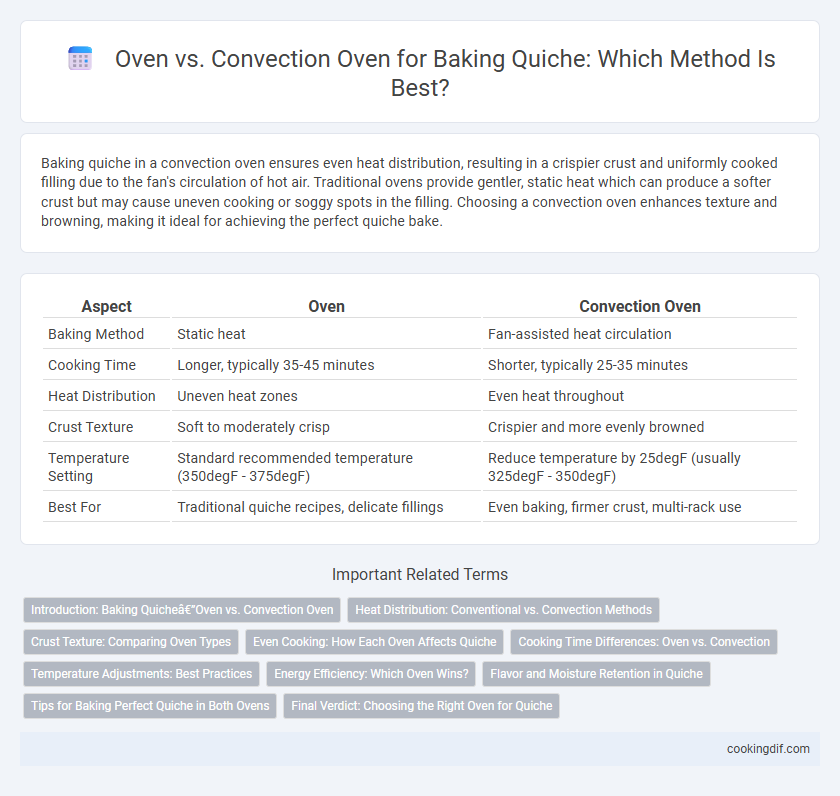Baking quiche in a convection oven ensures even heat distribution, resulting in a crispier crust and uniformly cooked filling due to the fan's circulation of hot air. Traditional ovens provide gentler, static heat which can produce a softer crust but may cause uneven cooking or soggy spots in the filling. Choosing a convection oven enhances texture and browning, making it ideal for achieving the perfect quiche bake.
Table of Comparison
| Aspect | Oven | Convection Oven |
|---|---|---|
| Baking Method | Static heat | Fan-assisted heat circulation |
| Cooking Time | Longer, typically 35-45 minutes | Shorter, typically 25-35 minutes |
| Heat Distribution | Uneven heat zones | Even heat throughout |
| Crust Texture | Soft to moderately crisp | Crispier and more evenly browned |
| Temperature Setting | Standard recommended temperature (350degF - 375degF) | Reduce temperature by 25degF (usually 325degF - 350degF) |
| Best For | Traditional quiche recipes, delicate fillings | Even baking, firmer crust, multi-rack use |
Introduction: Baking Quiche—Oven vs. Convection Oven
Baking quiche in a conventional oven ensures even, gentle heat that allows the custard filling to set without overbrowning the crust. A convection oven circulates hot air for faster cooking and a crisper, flakier crust but may require temperature adjustments to prevent drying out the filling. Understanding the nuances between these baking methods helps achieve the ideal texture and flavor in quiche preparation.
Heat Distribution: Conventional vs. Convection Methods
Conventional ovens rely on radiant heat, producing uneven temperature zones that can cause inconsistent quiche crust browning and custard setting. Convection ovens use a fan to circulate hot air, promoting uniform heat distribution and ensuring even cooking of both the quiche filling and crust. This difference in heat circulation leads to faster baking times and a consistently golden, crisp crust with a fully set interior in convection ovens.
Crust Texture: Comparing Oven Types
Traditional ovens provide consistent, even heat that helps develop a flaky, buttery quiche crust with a tender interior. Convection ovens, using a fan to circulate hot air, promote faster, more uniform browning and a crisper crust texture ideal for those who prefer a crunchier bite. The choice between oven types influences moisture retention and crust doneness, with convection ovens often reducing baking time while enhancing crust crispness.
Even Cooking: How Each Oven Affects Quiche
A convection oven circulates hot air evenly around the quiche, resulting in a uniformly cooked crust and filling with a golden-brown finish. Traditional ovens may create hot spots, causing uneven baking that can lead to soggy edges or an undercooked center. Optimal quiche texture and consistent doneness are more reliably achieved with convection baking due to enhanced heat distribution.
Cooking Time Differences: Oven vs. Convection
Baking a quiche in a convection oven typically reduces cooking time by 25% compared to a conventional oven due to the even air circulation that promotes faster heat transfer. Convection ovens often bake quiches in 25 to 30 minutes at 350degF, whereas conventional ovens require 35 to 45 minutes at the same temperature. Adjusting cooking time and temperature is essential to prevent over-browning and ensure a perfectly cooked, evenly set quiche.
Temperature Adjustments: Best Practices
When baking quiche, conventional ovens require a standard temperature of 350degF (175degC) for even cooking, while convection ovens should be set 25degF (15degC) lower to prevent over-browning due to enhanced air circulation. Adjusting temperature downward in convection ovens ensures the quiche's crust bakes to a golden crisp without drying out the custard filling. Maintaining proper temperature control between oven types promotes ideal texture and uniform cooking results.
Energy Efficiency: Which Oven Wins?
Convection ovens use a fan to circulate hot air, baking quiches more evenly and at lower temperatures, which reduces overall energy consumption. Traditional ovens heat the air slowly and unevenly, often requiring longer baking times and more energy. For energy-efficient quiche baking, convection ovens typically outperform conventional ovens by cutting down both cooking time and electricity usage.
Flavor and Moisture Retention in Quiche
Baking quiche in a conventional oven ensures even heat distribution, preserving moisture and enhancing the delicate custard texture while maintaining rich, balanced flavors. Convection ovens, with their circulating air, tend to cook faster and can create a firmer crust but may lead to slight moisture loss, potentially affecting the quiche's creamy consistency. For optimal flavor and moisture retention, traditional oven baking is preferred to achieve a tender, flavorful quiche with a perfectly set filling.
Tips for Baking Perfect Quiche in Both Ovens
For baking perfect quiche in a conventional oven, preheat to 350degF and use the middle rack to ensure even heat distribution, while covering the crust edges with foil prevents over-browning. In a convection oven, reduce the temperature to 325degF and check for doneness earlier due to faster cooking times, stirring the filling gently before baking helps maintain a creamy texture. Both methods benefit from blind baking the crust for 10-12 minutes to avoid sogginess and achieve a crisp, golden base.
Final Verdict: Choosing the Right Oven for Quiche
Baking quiche in a convection oven ensures even heat distribution and a crisp, golden crust due to the fan-assisted airflow, making it ideal for achieving professional-quality results. Traditional ovens provide slower, more uniform heat, which can be beneficial for delicate fillings to prevent overbaking or drying out. Selecting between convection and conventional ovens depends on prioritizing crust texture versus filling consistency for the perfect quiche.
oven vs convection oven for baking method Infographic

 cookingdif.com
cookingdif.com